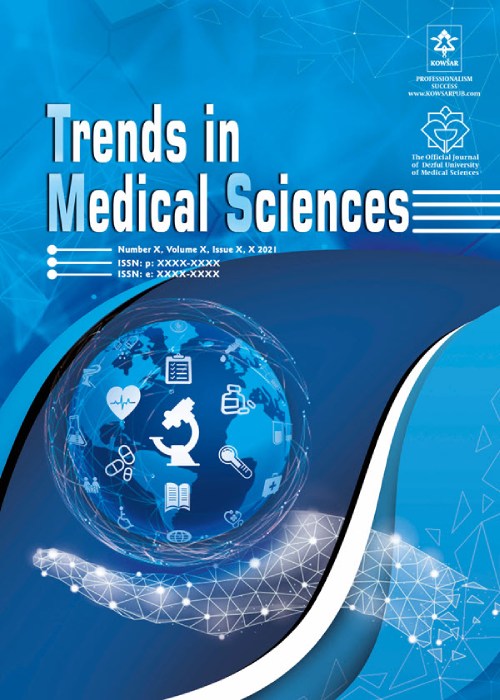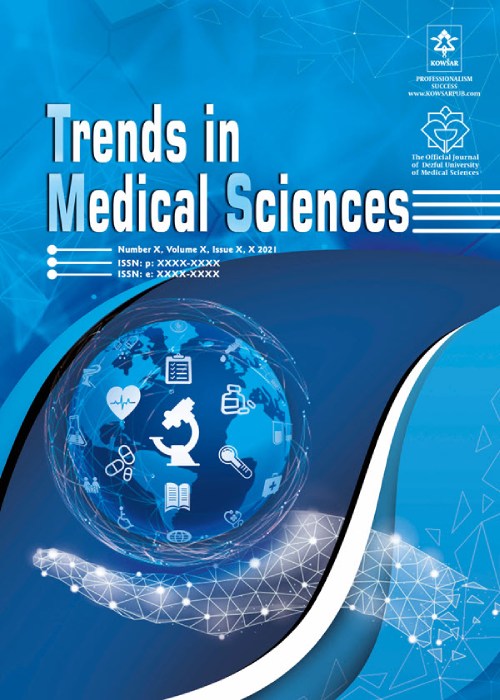فهرست مطالب

Journal of Trends in Medical Sciences
Volume:2 Issue: 3, Summer 2022
- تاریخ انتشار: 1401/06/14
- تعداد عناوین: 8
-
Page 1Background
Nurses encounter a lot of stressors in the workplace because of high workload, long working hours, and work-income imbalance, and these stressors have increased during the COVID-19 pandemic. Consequently, nurses’ occupational stress levels have also increased, thereby increasing the incidence of anxiety disorders. Evidence indicates that anxiety disorders may result from a lack of appropriate coping strategies.
ObjectivesThe present study aimed to determine the relationship between stress and coping strategies among nurses caring for COVID-19 patients.
MethodsThis descriptive study was conducted on 178 nurses selected by simple random sampling. Data was collected using Cohen’s Perceived Stress Scale, Lazarus and Folkman’sWays of Coping Questionnaire, and a demographic information form, and it was analyzed using SPSS 16 software.
ResultsThe results indicated that age and job tenure were directly associated with perceived stress. Accordingly, increases in age and job tenure were accompanied by increases in perceived stress (P < 0.05). The results also revealed a significant relationship between perceived stress and confrontative coping, distancing, self-controlling, seeking social support, accepting responsibility, planful problem-solving, and positive reappraisal strategies (P < 0.05).
ConclusionsThe study findings demonstrated that stress coping strategies differed among nurses depending on age, gender, education level, and other demographic features. As these factors cannot be changed in most cases, training nurses in stress coping strategies can reduce their perceived stress.
Keywords: Stress, Stress Coping Strategies, Nurse, Care -
Page 2Background
One of the most important factors in the success of assisted reproductive techniques is the quality of the embryo generated in the laboratory. Whether to transfer only one high-quality embryo or a combination of high- and low-quality embryos is a dilemma.
ObjectivesThe present study reviewed the embryo transfer records of IVF/intra cytoplasmic sperm injection (ICSI) patients in Dezful Infertility Center, Iran, to evaluate the impact of the simultaneous transfer of a low-quality embryo on the growth and implantation of a high-quality embryo and live birth.
MethodsThis cross-sectional study evaluated the files and records of 802 patients undergoing IVF/ICSI at Dezful Infertility Treatment Center from 2013 to September 2020. The patients were classified into group 1: Patients with the transfer of only one grade A (equal blastomeres without fragmentation) embryo, group 2: Patients with the transfer of two grade A and B (equal blastomeres with slight fragmentation) embryos, group 3: Patients with the transfer of two grade A and C (unequal blastomeres with or without fragmentation) embryos, and group 4: Patients with the transfer of two grade C and B embryos.
ResultsThe mean age of women and men was 32.52 ± 5.10 and 37.59 ± 6.60 years, respectively. Age, duration of infertility, cause of infertility, endometrial diameter, estradiol level, oocyte number, and embryo number had no significant differences between the groups (P> 0.05). Also, the findings indicated no significant differences between the groups in terms of implantation rate, live birth rate, fertility rate, multiple pregnancies rate, and chemical and clinical abortions (P > 0.05).
ConclusionsIt seems that the simultaneous transfer of embryos with different qualities does not affect the success rateandfertility outcomes in IVF/ICSI candidates.
Keywords: Infertility, Embryo Transfer, Embryo Quality, Fertility Outcome -
Page 3Background
Fetal abortion is one of the critical and controversial issues in most societies’ scientific, social, and academic ceremonies due to known and unknown reasons. Furthermore, updating our knowledge about isolated bacteria, their antibiotic resistance pattern, and related factors is essential for designing and implementing appropriate interventions.
ObjectivesThe current study was conducted to determine the prevalence of bacteria among fetal abortion cases and demonstrate the antimicrobial susceptibility among isolated bacteria.
MethodsFor this, 153 blood samples were collected percutaneously from the heart blood of aborted fetuses 1 - 15 hours after birth; subsequently, the identification of bacteria and evaluation of antimicrobial susceptibility testing were performed.
ResultsGenerally, 82 out of 153 test cultures were positive, comprising 66 and 26 Gram-negative and Gram-positive bacteria, respectively. The most isolated bacteria among Gram-negative isolates were Acinetobacter spp. (34/82) and Escherichia coli (17/82). Likewise, the highest antibiotic resistance was detected for Acinetobacter spp. against cefixime, amikacin, gentamycin, and ciprofloxacin (24/34). On the other hand, Staphylococcus spp. was the predominant Gram-positive cocci (10/82). Also, the highest resistance for Staphylococcus spp. was against cefoxitin and ciprofloxacin (100%).
ConclusionsIt seems more focus on following the general hygiene of pregnant mothers is essential. However, further evidence of a clinical correlation between aborted fetuses and their mothers is required.
Keywords: Abortion, Etiology, Fetal Death, Gram-Negative Bacteria, Gram-Positive Bacteria -
Page 4Background
Schistosomiasis is a chronic parasitic and often weakening disease, which was endemic in Khuzestan Province, Southwest Iran.
ObjectivesThis study aimed to determine the prevalence of Schistosomiasis in the north of Khuzestan province.
MethodsThe current study was carried out based on the parasitological method to observe the ova of the parasite in urine by light microscopy and serology method based on titer the volume of Immunoglobulin G (IGg) in the blood serum of school children.
ResultsThe observation of parasite eggs in urine samples and the prevalence of infection based on examining antibodies against Schistosoma haematobium infection in the blood serum of students was zero.
ConclusionsBased on the findings, the cessation of transmission and elimination of the disease in the investigated area in the north of Khuzestan province have appeared.
Keywords: Schistosoma haematobium, Epidemiology, Iran -
Page 5Background
Immune system disorders are one of the main problems in end-stage renal disease (ESRD) patients undergoing hemodialysis. The weakening of the immune system in these patients makes them susceptible to various infections.
ObjectivesThis research was conducted for the first time to investigate the prevalence of naturally acquired immunity to Meningococcus and its association with the duration of dialysis, gender, and age in hemodialysis patients.
MethodsThis descriptive cross-sectional study was conducted on patients suffering from chronic kidney disease undergoing hemodialysis referring to Jahrom Hemodialysis Center in March-August 2022. The qualitative level of anti-meningococcal polysaccharide antibodies was determined in serum samples using ELISA assay with specialized and commercial kits to determine the immunity to Meningococcus. Stata version 14 was used to analyze the data with the chi-square test, univariate, and multivariable logistic regression.
ResultsThe prevalence of naturally acquired immunity to Meningococcus was 18.68% in hemodialysis patients. Sex, age, duration of hemodialysis, and the number of weekly dialysis sessions were associated with the acquired immunity to Meningococcus.
ConclusionsAs hemodialysis patients are not vaccinated against meningococci in Iran, 18.68% of the hemodialysis patients had a history of meningococcal infection. Considering the susceptibility of these patients to this infectious disease and its preventability, it is recommended to vaccinate these patients against meningococcal infection.
Keywords: Naturally Acquired Immunity, Meningococcus, Hemodialysis Patients -
Page 6Background
The circle of Willis is an anastomotic network of arteries surrounding the base of the brain. People with effective collateral circulation will lower the risk of transient ischemic attack and stroke than those with ineffective collaterals.
ObjectivesThe research aims to study the diameter of arteries and determine the frequency and patterns of anatomical variations in Vietnamese patients’ anterior and posterior parts of the Willis polygon.
MethodsThis descriptive cross-sectional study was conducted in Vietnam at Bach Mai hospital between July 2010 and July 2011. A total of 102 MSCT 64 examinations were conducted on adult patients with suspected cerebrovascular diseases such as stroke, cerebral infarction, etc. The average internal diameter of arteries was estimated using descriptive statistics. Wilcoxon signed-rank test paired t-test to compare diameter on the left and right sides.
ResultsThere are four types of anterior parts and twelve types of posterior parts in the circle of Willis. Of the 102 subjects, 29.41% experienced the anterior part of circle of Willis (CoW), in which aplastic anterior communicating artery (ACoA) is the mostcommon type (21.57%). 70.59% of all subjects have variations in the posterior part of CoW, and bilateral aplastic posterior communicating artery (PCoA) is the most common type (20.59%). We also report the diameter of cerebral artery segments of the circle of Willis. There are six variations in the circle of Willis based on the correlation between pre communicating part P1 of posterior cerebral artery (PCA) (P1) and PCoA diameter. The most popular type is adult configuration (53.92%).
ConclusionsWe provided the prevalence and the pattern of the brain vascular variants of the circle of Willis in a group of patients diagnosed with ischemic stroke. Understanding the variations and diameter of the circle of Willis is of great importance in interventional radiology for various endovascular interventions in Vietnamese patients.
Keywords: Cerebral Arteries, Circle of Willis, Diameter of Artery, Anatomic Variation, Diagnostic Imaging


